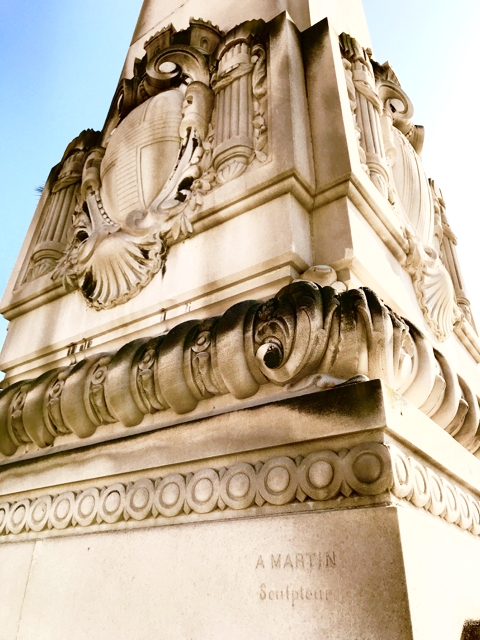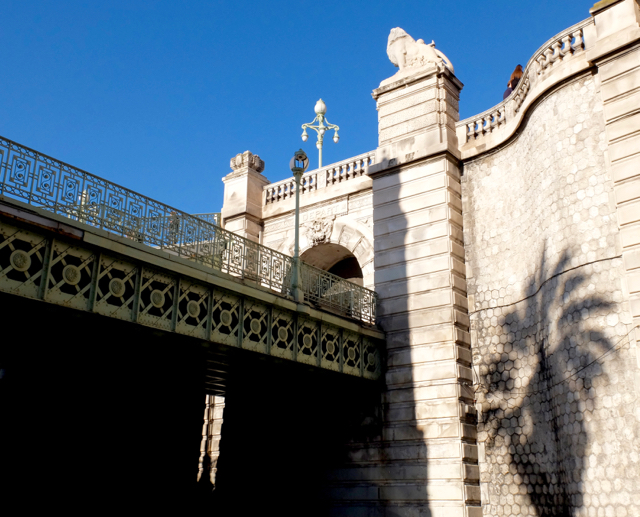a grand entrance
New York’s Grand Central Station has its iconic constellation ceiling that entices even the most harried commuters to look up. The lofty iron roof at Paris’ Gare Saint-Lazare is immortalized in Monet’s masterpiece, his sumptuous clouds of steam capturing the romance of train travel. Here in Marseille, the Gare Saint-Charles has a grand staircase that spills into the city. The escaliers are flanked by majestic statues and palm trees with rows of Art Nouveau bronze dolphin lampposts cascading down the middle. You feel like a royal descending into a ball, even when lugging an awkward suitcase. There’s so much architectural eye candy the stairs are a destination in its own right. Here’s some backstory for my fellow history buffs.
The escaliers were built eight decades after Saint-Charles’ 1848 construction. Seeing the need to connect the hilltop train station to the Boulevard d’Athènes--the main artery that descends to the Vieux Port--city planners bid au revoir to obstructing buildings to make space for the stairs. Eugène Sénès, architect of the nearby Bourse de Travail, completed the 104 steps of history in 1927. Made by prominent Marseille sculptors, the statues are full of regional, colonial, and maritime motifs that pay homage to this multinational nautical nature of this port city.
The bottom of the staircase is bookended by two statues designed by Louis Bottinelly. Like Marianne, France's own Lady Liberty and national symbol, the local sculptor uses the female form as metaphor. Botinelly’s monumental women represent Marseille’s connection to lands near and far. In the Colonies d'Afrique, an African woman with braided hair and tribal jewelry regally reclines among a monkey, mask, and elephant tusks. Like a Khmer princess, the Colonies D’Asie heroine is crowned with an ornate headdress. She lounges on a shell seat with an Asian vase and Khmer lion besides her. Children are featured in all of the staircase's statues, a wink to Marseille’s patron saint, the Bonne Mère.
As you make your way up the stairs, a sextet of bronze statues lines the guardrails. Henri Raynaud's chubby cherubs correspond with rich Provencal traditions: fruits, flowers, farming, fishing, hunting, and wine. In les vendanges, they bask in the grape bunches picked for the wine harvest. A cherub clutches a bow and arrow above his hunting prize, a dead goose, in la chasse.
On the middle landing, Auguste Carli’s allegorical females captain ships helmed by proud rams’ figureheads. The towering beauty on the right, the Porte de l’Orient, represents the port’s flow of immigration and trade. Encircled by griffons (the mythical animal with a lion’s body and eagle’s wings), she is the ultimate strong marseillaise sporting a seashell tiara and toga with a trident in hand.
On the left, the Colonie Grecque personifies Marseille’s beginning as the Greek colony, Massalia, 2600 years ago. She sits confidently poised on an antique chair, draped in a traditional chlamyde, unlike her bare-breasted counterpart. She holds a fellow female badass, a small statue of Artemis—the Greek goddess of the hunt.
The lantern-topped pillars feature crests of French cities by sculptor Henri Martin. Marseille’s armoirie faces the train station—its cross is the same as the city flag. The Porte de l’Orient has Aix en Provence’s striped crest on her left and Nice’s eagle on her right. Find Lyon’s lion on the Colonie Greque’s right and Paris’s ship on her left.
Before you continue up, don’t miss the two Arrivée and Départ archways that bookend the next level of steps. They feature an aquarium of motifs—crabs, crustaceans, seahorses, fish, and shells. In spite of their splendor, they lead to a nondescript street, not the train station. Watch your step—they happen to be a popular spot for public peeing.
Two lion and child statues flank the top of the stairs. Made by Marseille’s prominent animal sculptor, Ary Bitter, these noble lions symbolize strength and vigilance. Each statue has it’s own inscription: Le soleil et la mer – the sun and the sea, and le monde and l’energie – the world and vigor. Don’t forget to look out -- the top esplanade boasts an epic view of Notre Dame de la Garde in the distance.
Fitting for this populaire city, the stairs are a vertical urban park where locals and tourists gather for a snack before the train, some reading in the sun, or a smoke amongst friends. Next time you take the train, take the time to see these statues up close.
fyi At the bottom of the steps, Café l’Écomotive serves awesome lattes, salads, quiches, and Wifi to travelers and locals in the know.
nearby Marseille’s other golden girl, the Vierge Dorée, is just down the street at the corner of rue de les Héros and Boulevard Voltaire. A symbol of the Immaculate Conception, the gilded virgin had to be moved when the stairs were built.
Escaliers Gare St. Charles
Square Narvik
Saint-Charles
















